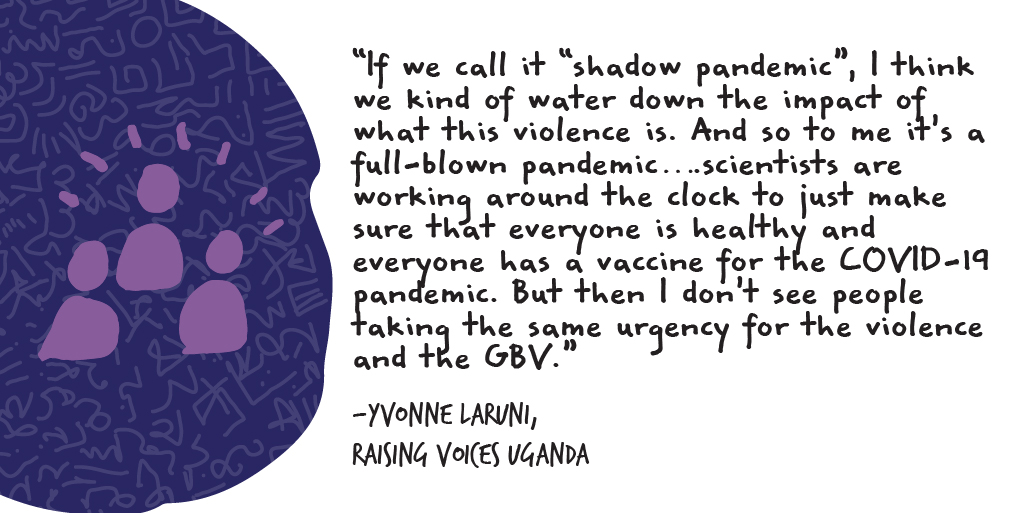Whether on Twitter, online, in the news, you may have heard the term “shadow pandemic”, to describe the growing rates of violence against women and girls amid the COVID-19 pandemic. This is a narrative that has been taken up by development actors around the world — from international agencies to research institutes, NGOs and activists. But what is really meant by “shadow pandemic”, and why does it matter?
The language we use to describe our realities is important. In Narrative Power and Collective Action: Conversations with people working to change narratives for social good, Elena Mejia Julca describes narratives as “an interpretation of reality that serves the interests of the group that constructs them. And they can have a very direct impact on the action and behaviour of people.” These interpretations — whether in policy language or advocacy language — can also affect our understanding of certain places, groups and issues. For example, if we talk about sexual and gender-based violence (SGBV) in the same way we talk about a virus — in terms of “flattening the curve” or as a parallel “pandemic” — this could impact the way we think about the issue, and therefore the response or interventions required to overcome it.
The language we use to describe our realities is important
JASS (Just Associates) conceptualize narratives as a form of “invisible power” in terms of shaping and reinforcing meaning, values and what is considered ‘normal’ or accepted in the status quo. In this sense, understanding where dominant narratives are coming from, and what purpose they serve, is critically important. The “shadow pandemic” narrative has become so prevalent in the current development discourse that it is a broadly accepted way to describe violence against women and girls during COVID-19. There is a usefulness to this prevalence and its conciseness. For so many development actors and activists (including UNGEI) whose advocacy efforts are increasingly conducted in the digital space and limited to 240 characters, the harrowing realities of violence can be encapsulated — or neatly avoided — with these two words. But there is also so much which is omitted from the narrative, including the diverse and complex realities of the women and girls who are facing sexual and gender-based violence (SGBV) that it describes.
‘Real’ reflections on the narrative of a “shadow pandemic”
In December 2020, UNGEI hosted a Real Talk event on “Tackling the Shadow Pandemic” with an expert panel of feminist activists, researchers, leaders and teachers working to address SGBV in educational settings. We asked them what they thought of the term “shadow pandemic”, and whether it accurately describes what is actually going on. What emerged was a nuanced and deep reflection on discourse, something which we feel is often lacking in our sector. We discuss some of these reflections below.


Panelists debated the idea that whilst ‘shadow’ implies something hidden, for those who are actively experiencing GBV, it’s not hidden at all. It’s true that under-reporting is a huge issue when it comes to gender-based violence, but if we refer to it as something in the shadows, could this compound our collective ability to sweep it under the carpet?


Focusing more on the terminology of a ‘pandemic’ to describe gender-based violence, the idea was raised that ‘pandemic’ describes a new phenomenon, or a new outbreak, like COVID-19. This fails to acknowledge the fact that SGBV was a global challenge long before the pandemic, and is a challenge that we will continue to face once the pandemic subsides.

The discussion then moved to the impacts of the harmful subtexts of the “shadow pandemic” discourse, and the possible implications for our struggle to overcome gender-based violence in our schools and our societies. By referring to SGBV as a parallel pandemic in our discourse, rather than a part of the COVID-19 pandemic that must be integrated across crisis and recovery plans, there is a risk of SGBV being sidelined in terms of funding and priority.

Going further, this conceptualization of a ‘pandemic’ suggests a short-termist agenda needing quick and decisive interventions. This very much goes against what we know to be true about dismantling the driving forces of SGBV- that, among other factors, efforts must be community-centred, with long-term and transformative social and gender norm change at the forefront. This work had been taking place long before the COVID-19 pandemic started, and must continue long after it subsides.
Panellists also considered that a ‘crisis’ discourse prompts an understanding of gender-based violence as something that the international community can respond to and then move on, glossing over the deep impacts of SGBV on our lives, our schools, and our societies.
Shifting power in development discourse: a call to action for 2021
By looking at the nuances of the “shadow pandemic” narrative, we can see the power of discourse in development more broadly, and its implications in terms of tangible actions and funding. As development actors and activists, we must be aware of the risk of unintentionally abusing the power we have, in the narratives that we use and champion.

This quote is taken from the Real Talk: Tackling the Shadow Pandemic event. Design by Jeyda Bicer/UNGEI.
This blog aims to emphasize the need to give attention to, and reflect on, the narrow spectrum of voices in development who are empowered to create and shape narratives — which often go hand-in-hand with courses of policy action and resources.

This quote is taken from the Real Talk: Tackling the Shadow Pandemic event. Design by Jeyda Bicer/UNGEI.
As such, these are our recommendations to shift power in development discourse:
- We recommend that the development sector stays more attentive to the potential impacts of harmful narratives, and is more intentional with the language and discourse used in advocacy and communications.
- We recommend that organisations create a space to question narratives in a conscious way. Take a reflective approach to new development “buzzwords” and discourse before adopting them. A statement of intent can support chosen narratives and discourse.
- We recommend that individuals and groups affected by the issues control the discourse. “Nothing about us, without us”.
- We recommend that multilateral organisations, INGOs, and UN agencies go beyond asking for opinions and perspectives of affected groups, to truly listen to the stories and experiences from the ones who live the reality.
2020 was a powerful year for uprising against existing power structures. From the Black Lives Matter, Revolution Now, EndSARS, and #MeToo movements, the world is reckoning with its institutional racism and patriarchy. The development sector has its own colonial and patriarchal structures which must be dismantled across the board, including in its discourse. In 2021, we urge development actors and activists to take these recommendations on board, and maintain an intentional approach to the shifting of power and use of discourse in development.



 English
English العربية
العربية Български
Български Hrvatski
Hrvatski Čeština
Čeština Dansk
Dansk Nederlands
Nederlands Suomi
Suomi Français
Français Deutsch
Deutsch Ελληνικά
Ελληνικά हिन्दी
हिन्दी Italiano
Italiano Română
Română Русский
Русский Español
Español Maltese
Maltese Zulu
Zulu አማርኛ
አማርኛ